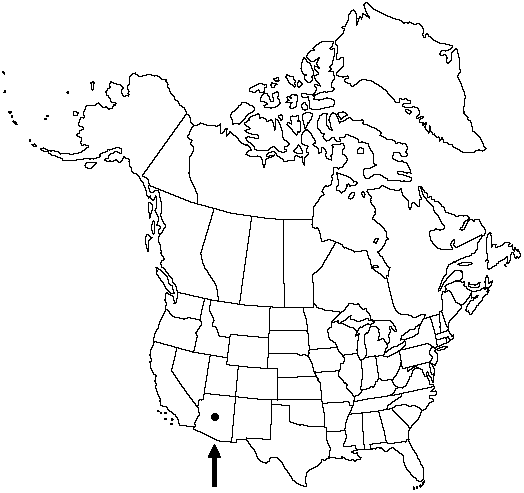Difference between revisions of "Pellaea lyngholmii"
Contr. Univ. Michigan Herb. 19: 40. 1993.
FNA>Volume Importer |
imported>Volume Importer |
||
| (7 intermediate revisions by 2 users not shown) | |||
| Line 6: | Line 6: | ||
|place=19: 40. 1993 | |place=19: 40. 1993 | ||
|year=1993 | |year=1993 | ||
| + | }} | ||
| + | |special_status={{Treatment/ID/Special_status | ||
| + | |code=E | ||
| + | |label=Endemic | ||
}} | }} | ||
|basionyms= | |basionyms= | ||
| Line 16: | Line 20: | ||
}}<!-- | }}<!-- | ||
| − | --><span class="statement" id="st- | + | --><span class="statement" id="st-undefined" data-properties=""><b>Stems </b>compact, ascending, stout, 5–10 mm diam.; scales uniformly brown or tan, linear-subulate, 0.1–0.3 mm wide, thin, margins entire to denticulate. <b>Leaves</b> somewhat dimorphic, sterile leaves shorter and less divided than fertile leaves, clustered on stem, 10–30 cm; croziers villous. <b>Petiole</b> dark brown to reddish purple, lustrous, rounded adaxially, without prominent articulation lines. <b>Blade</b> elongate-deltate to ovate, 2-pinnate proximally, 5–15 cm wide; rachis brown or reddish purple throughout, straight, often slightly flattened adaxially, sparsely villous with long, divergent hairs. <b>Pinnae</b> perpendicular to rachis or slightly ascending, not decurrent on rachis, usually with 7–15 ultimate segments; costae straight, 25–80 mm, usually longer than ultimate segments. <b>Ultimate</b> segments oblong-lanceolate, 7–25 mm, leathery, sparsely villous abaxially near midrib; margins usually recurved on fertile segments, covering less than 1/2 abaxial surface, borders whitish, crenulate; apex slightly mucronate. <b>Veins</b> of ultimate segments obscure. <b>Sporangia</b> long-stalked, containing 32 spores, not intermixed with farina-producing glands.</span><!-- |
-->{{Treatment/Body | -->{{Treatment/Body | ||
| + | |phenology=Sporulating summer–fall. | ||
|habitat=Rocky slopes and ledges, usually on sandstone | |habitat=Rocky slopes and ledges, usually on sandstone | ||
|elevation=1200–1800 m | |elevation=1200–1800 m | ||
|distribution=Ariz. | |distribution=Ariz. | ||
| − | |discussion=<p>Pellaea lyngholmii is an apogamous tetraploid that arose through hybridization between P. atropurpurea and P. truncata (M. D. Windham 1993). It is most often confused with P. atropurpurea, from which P. lyngholmii differs in having sparsely villous rachises, smaller and more numerous ultimate segments, and spores usually more than 62 µm in diameter.</p> | + | |discussion=<p><i>Pellaea lyngholmii</i> is an apogamous tetraploid that arose through hybridization between <i>P. atropurpurea</i> and <i>P. truncata</i> (M. D. Windham 1993). It is most often confused with <i>P. atropurpurea</i>, from which <i>P. lyngholmii</i> differs in having sparsely villous rachises, smaller and more numerous ultimate segments, and spores usually more than 62 µm in diameter.</p> |
|tables= | |tables= | ||
|references= | |references= | ||
| Line 31: | Line 36: | ||
-->{{#Taxon: | -->{{#Taxon: | ||
name=Pellaea lyngholmii | name=Pellaea lyngholmii | ||
| − | |||
|authority=Windham | |authority=Windham | ||
|rank=species | |rank=species | ||
| Line 38: | Line 42: | ||
|basionyms= | |basionyms= | ||
|family=Pteridaceae | |family=Pteridaceae | ||
| + | |phenology=Sporulating summer–fall. | ||
|habitat=Rocky slopes and ledges, usually on sandstone | |habitat=Rocky slopes and ledges, usually on sandstone | ||
|elevation=1200–1800 m | |elevation=1200–1800 m | ||
| Line 44: | Line 49: | ||
|publication title=Contr. Univ. Michigan Herb. | |publication title=Contr. Univ. Michigan Herb. | ||
|publication year=1993 | |publication year=1993 | ||
| − | |special status= | + | |special status=Endemic |
| − | |source xml=https:// | + | |source xml=https://bitbucket.org/aafc-mbb/fna-data-curation/src/2e0870ddd59836b60bcf96646a41e87ea5a5943a/coarse_grained_fna_xml/V2/V2_743.xml |
|genus=Pellaea | |genus=Pellaea | ||
|species=Pellaea lyngholmii | |species=Pellaea lyngholmii | ||
| − | |||
| − | |||
| − | |||
| − | |||
| − | |||
| − | |||
| − | |||
| − | |||
| − | |||
| − | |||
| − | |||
| − | |||
| − | |||
| − | |||
| − | |||
| − | |||
| − | |||
| − | |||
| − | |||
| − | |||
| − | |||
| − | |||
| − | |||
| − | |||
| − | |||
| − | |||
| − | |||
| − | |||
| − | |||
| − | |||
| − | |||
| − | |||
| − | |||
| − | |||
| − | |||
| − | |||
| − | |||
| − | |||
| − | |||
| − | |||
| − | |||
| − | |||
| − | |||
| − | |||
| − | |||
| − | |||
| − | |||
}}<!-- | }}<!-- | ||
-->[[Category:Treatment]][[Category:Pellaea]] | -->[[Category:Treatment]][[Category:Pellaea]] | ||
Latest revision as of 20:25, 5 November 2020
Stems compact, ascending, stout, 5–10 mm diam.; scales uniformly brown or tan, linear-subulate, 0.1–0.3 mm wide, thin, margins entire to denticulate. Leaves somewhat dimorphic, sterile leaves shorter and less divided than fertile leaves, clustered on stem, 10–30 cm; croziers villous. Petiole dark brown to reddish purple, lustrous, rounded adaxially, without prominent articulation lines. Blade elongate-deltate to ovate, 2-pinnate proximally, 5–15 cm wide; rachis brown or reddish purple throughout, straight, often slightly flattened adaxially, sparsely villous with long, divergent hairs. Pinnae perpendicular to rachis or slightly ascending, not decurrent on rachis, usually with 7–15 ultimate segments; costae straight, 25–80 mm, usually longer than ultimate segments. Ultimate segments oblong-lanceolate, 7–25 mm, leathery, sparsely villous abaxially near midrib; margins usually recurved on fertile segments, covering less than 1/2 abaxial surface, borders whitish, crenulate; apex slightly mucronate. Veins of ultimate segments obscure. Sporangia long-stalked, containing 32 spores, not intermixed with farina-producing glands.
Phenology: Sporulating summer–fall.
Habitat: Rocky slopes and ledges, usually on sandstone
Elevation: 1200–1800 m
Discussion
Pellaea lyngholmii is an apogamous tetraploid that arose through hybridization between P. atropurpurea and P. truncata (M. D. Windham 1993). It is most often confused with P. atropurpurea, from which P. lyngholmii differs in having sparsely villous rachises, smaller and more numerous ultimate segments, and spores usually more than 62 µm in diameter.
Selected References
None.
